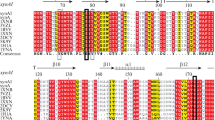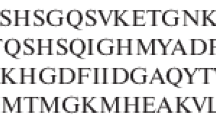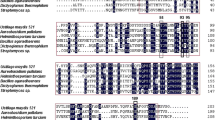Abstract
Endo-1,4-β-xylanases from Bacillus pumilus VKPM В-7975, Paenibacillus polymyxa VKPM В-3015, Thermomyces lanuginosus VKPM F-224, and Schizophyllum commune VKPM F-433, which are members of a family of 11 glycohydrolases, have been obtained in the expression system of Pichia pastoris. Technologically valuable characteristics of the recombinant hydrolases, such as the specific activity, pH and thermal stability, temperature and pH optima, resistance to digestive enzymes and xylanase protein inhibitors from cereals, and substrate specificity were studied. It was shown that the enzyme from Paenibacillus polymyxa has the highest biotechnological potential for the creation of xylanases based on the recombinant Pichia pastoris yeast strain for their use in fodder production.






Similar content being viewed by others
REFERENCES
Ebringerova, A. and Heinze, T., Xylan and xylan derivatives – biopolymers with valuable properties. 1: Naturally occurring xylans structures, isolation procedures and properties, Macromol. Rapid. Commun., 2000, vol. 21, no. 9, pp. 542–556. https://doi.org/10.1002/1521-3927(20000601)21:9<542::AID-MARC542>3.0.CO;2-7
Coughlan, M.P. and Hazlewood, G.P., β-1,4-D-Xylan-degrading enzyme systems, biochemistry, molecular biology and applications, Biotechnol. Appl. Biochem., 1993, vol. 5, no. 17, pp. 259–289.
Kulkarni, N., Shendye, A., and Rao, M., Molecular and biotechnological aspects of xylanases, FEMS. Microbiol. Rev., 1999, vol. 5, no. 23, pp. 411–456.
Coughlan, M.P. and Hazlewood, G.P., β-1,4-D-Xylan-degrading enzyme systems, biochemistry, molecular biology and applications, Biotechnol. Appl. Biochem., 1993, vol. 5, no. 17, pp. 259–289.
Subramaniyan, S. and Prema, P., Biotechnology of microbial xylanases: enzymology, molecular biology, and application, Crit. Rev. Biotechnol., 2002, vol. 22, pp. 33–64. https://doi.org/10.1080/07388550290789450
Harris, A.D. and Ramalingam, C., Xylanases and its application in food industry: a review, J. Exp. Sci., 2010, vol. 1, no. 7, pp. 1–11.
Beg, Q.K., Kapoor, M., Mahajan, L., and Hoondal, G.S., Microbial xylanases and their industrial applications: a review, Appl. Microbiol. Biotechnol., 2001, vol. 56, pp. 326–338.
Gellissen, G., Heterologous protein production in methylotrophic yeasts, Appl. Microbiol. Biotechnol., 2000, vol. 54, no. 6, pp. 741–750.
Cereghino, J.L. and Cregg, J.M., Heterologous protein expression in the methylotrophic yeast Pichia pastoris,FEMS. Microbiol. Rev., 2000, vol. 24, pp. 45–66. https://doi.org/10.1111/j.1574-6976.2000.tb00532.x
Sumner J.B., Somers G.F. Dinitrosalicylic method for glucose, in Laboratory Expression in Biological Chemistry, New York: Academic, 1949.
Teixeira, M.C., Alcazar, A.C., and Princi, E., Characterization of alkaline xylanases from Bacillus pumilus,Braz. J. Microbiol., 2000, vol. 31, pp. 90–94. https://doi.org/10.1590/S1517-83822000000200005
Maha, T.H. Emam, KarimaA., et al., Cloning, sequencing and expression of the xylanase gene from Bacillus pumilus GH in Escherichia coli,Int. J. Chem. Tech. Res., 2016, vol. 9, no. 12, pp. 114–124.
Yang, R.C.A., Mackenzie, C.R., Bilous, D., et al., Molecular cloning and expression of a xylanase gene from Bacillus polymyxa in Escherichia coli,Appl. Environ. M-icrobiol., 1988, vol. 54, no. 4, pp. 1023–1029.
Morales, P., Madarro, A., Perez-Gonzalez, J.A., et al., Purification and characterization of alkaline xylanases from Bacillus polymyxa,Appl. Environ. Microbiol., 1993, vol. 59, no. 5, pp. 1376–1382.
Khucharoenphaisan, K. and Sinma, K., β-Xylanase from Thermomyces lanuginosus and its biobleaching application, Pakistan J. Biol. Sci., 2010, vol. 13, no. 11, pp. 513–526.
Oku, T., Roy, C., Watsona, D.C., et al., Amino acid sequence and thermostability of xylanase A from Schizophyllum commune, FEBS Lett., 1993, vol. 334, no. 3, pp. 296–300.
Paice, G., Jurasek, L., Carpenter, M.R., and Smillie, L.B., Production, characterization, and partial amino acid sequence of xylanase A from Schizophyllum commune,Appl. Environ. Microbiol., 1978, vol. 36, no. 6, pp. 802–808.
Fernandes, P., Enzymes in food processing: a condensed overview on strategies for better biocatalysts, Enzyme Res., 2010, vol. 2010, pp. 3–21. https://doi.org/10.4061/2010/862537
Bustany, A.Z., The effect of pelleting an enzyme-supplemented barley-based broiler diet, Anim. Feed Sci. Technol., 1996, vol. 58, no. 3, pp. 283–288.
Gusakov, A.V., Proteinaceous inhibitors of microbial xylanases, Biochemistry (Moscow), 2010, vol. 75, no. 10, pp. 1185–1199.
Naatsaari, L., Mistlberger, B., Ruth, C., et al., Deletion of the Pichia pastoris KU70 homologue facilitates platform strain generation for gene expression and synthetic biology, PLoS One, 2012, vol. 7. e. 39720. https://doi.org/10.1371/journal.pone.0039720
Sagt, B., Kleizen, R., Verwaal, M.D.M., et al., Introduction of an N-Glycosylation site increases secretion of heterologous proteins in yeasts, Appl. Environ. Mi-crobiol., 2000, vol. 66, no. 11, pp. 4940–4944.
Minghai, H. and Xiaobin, Y., Enhanced expression of heterologous proteins in yeast cells via the modification of N-glycosylation sites. Bioengineered, 2015, vol. 6, no. 2, pp. 115–118. https://doi.org/10.1080/21655979.2015.1011031
Funding
The work was supported by the Ministry of Education and Science of the Russian Federation (Unique Project Identifier RFMEFI60717X0180) with the Multipurpose Scientific Installation of the All-Russian Collection of Industrial Microorganisms of the National Bioresource Center, Kurchatov Institute (GOSNIIGENETIKA).
Author information
Authors and Affiliations
Corresponding author
Ethics declarations
The authors declare that they have no conflict of interest. This article does not contain any studies involving animals or human participants performed by any of the authors.
Additional information
Translated by I. Gordon
Abbreviations: CMC, carboxymethyl cellulose; GH11, family of 11 glycohydrolases; PAGE, polyacrylamide gel electrophoresis; SDS, sodium lauryl(dodecyl) sulphate; SDS-PAGE, protein PAGE in the occurrence of SDS; VKPM, All-Russia Collection of Industrial Microorganisms.
Rights and permissions
About this article
Cite this article
Kalinina, A.N., Borshchevskaya, L.N., Gordeeva, T.L. et al. Comparison of Xylanases of Various Origin Obtained in the Expression System of Pichia pastoris: Gene Expression, Biochemical Characteristics, and Biotechnological Potential. Appl Biochem Microbiol 55, 733–740 (2019). https://doi.org/10.1134/S0003683819070044
Received:
Revised:
Accepted:
Published:
Issue Date:
DOI: https://doi.org/10.1134/S0003683819070044




